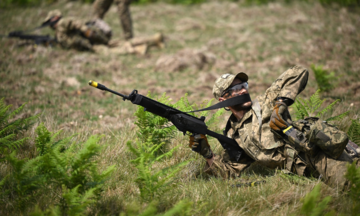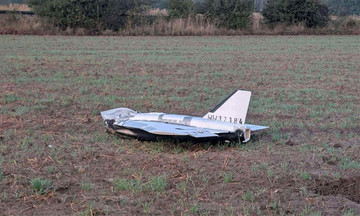An Iskander-M tactical ballistic missile battery struck a Ukrainian S-300PS air defense system near the settlement of Progress in Chernihiv province, the Russian Ministry of Defense announced on 20/9.
The ministry released thermal imaging video from a reconnaissance UAV, showing the dispersed S-300PS battery within a wooded area. The footage reveals the 30N6 fire control radar positioned on a 40V6M elevating tower, approximately 40 meters high, to extend its operational range. Other components, including the command vehicle and transporter-erector-launcher, were located nearby.
The Iskander-M missile then detonated its cluster munition warhead above the S-300PS battery, showering the area with submunitions. Russian UAVs continued to monitor the area, recording multiple fires, secondary explosions, and Ukrainian rescue efforts at the scene.
The attack destroyed the fire control radar, command post, two launchers, and two other vehicles, the Russian Ministry of Defense stated.
Ukrainian officials have not yet commented on the report.
The Belgium-based analysis group Army Recognition noted that each Iskander-M missile carries 54 9N730 fragmentation submunitions. The Iskander-M warhead typically releases these submunitions at altitudes of 900-1,400 meters above the target. The submunitions detonate 6-10 meters above the ground, impacting an area equivalent to several football fields.
The Soviet Union introduced the S-300 long-range air defense system in the late 1970s, with three main variants: the S-300P for air defense forces, the S-300V for ground forces, and the S-300F for naval vessels.
The S-300PS version debuted in 1982, featuring fully self-propelled combat vehicles, unlike the original S-300P, which relied on trailers and tow vehicles. The S-300PS also employed the 5V55R missile with a 75 km range, a significant improvement over the 47 km range of the 5V55K missile used by the S-300P.
The S-300PS is considered technologically comparable to the American Patriot air defense system, but with enhanced mobility and low-altitude target engagement capabilities.
The precise number of S-300 missiles in Ukraine's possession remains unclear. The country has deployed numerous Soviet-era S-300PT and S-300PS systems for air defense.
The Russian military has repeatedly targeted Ukrainian S-300 batteries, including initial strikes on military bases in the early stages of the conflict and subsequent attacks using suicide UAVs and guided missiles against S-300 units both deployed and in transit.
Thanh Tam (Theo Zvezda, Army Recognition)












